What is TFT LCD Display - Understand the Variants
1. Introduction: The Enduring Legacy of TFT LCDs
Thin-Film Transistor Liquid-Crystal Displays (TFT LCDs) are a foundational technology in modern electronics, found in everything from consumer gadgets to industrial and medical equipment. As an "active matrix" variant of LCDs, they offer significantly improved image quality and performance over older passive matrix designs. Their widespread adoption is due to mature technology, cost-effectiveness, and reliability, maintaining market presence even with newer innovations like OLEDs and MicroLEDs. The active matrix design, using individual transistors for each pixel, ensures faster refresh rates and enhanced image stability, enabling high-resolution, dynamic visual content.
2. The Foundational Structure of TFT LCDs
A TFT LCD is an active-matrix liquid crystal display that uses thin-film transistors (TFTs) to precisely control each pixel or sub-pixel by regulating voltage to its liquid crystal layer. This active control allows pixels to retain charge, leading to faster response times, higher resolutions, and improved image stability.
TFT LCDs are built from multiple integrated layers:
- Backlight Module: Provides uniform illumination, typically white LEDs.
- Polarizers: Two polarizing filters, one at the front and one at the back of the liquid crystal layer, are crucial for converting the unpolarized light from the backlight into polarized light that the liquid crystals can manipulate.
- Glass Substrates: Sandwich the liquid crystal layer, supporting the TFT array and pixel electrodes.
- Liquid Crystal Layer: Contains rod-shaped molecules that align with electric fields. This alignment dictates how much light passes through to the next layer.
- Thin-Film Transistor (TFT) Array: Millions of transistors controlling individual sub-pixels, with capacitors for charge retention.
- Pixel Electrodes: Transparent electrodes applying electric fields to liquid crystals.
- Color Filters: To produce the full spectrum of colors we see on a TFT LCD, Red, green, and blue filters for full-color image production.
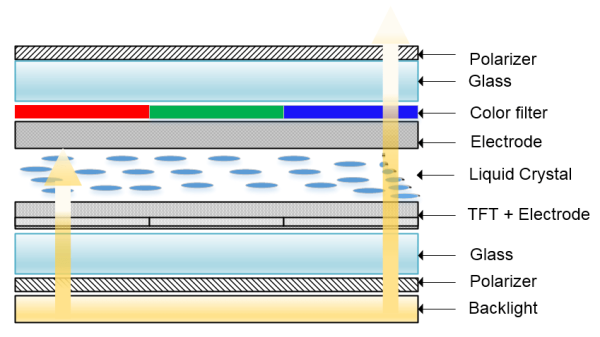
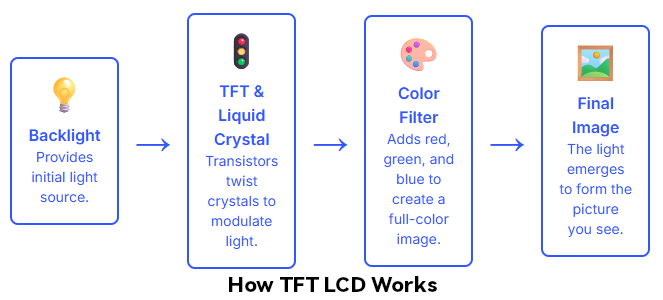
For more TFT LCD Technology information, please read along:
Six ways to improve TFT LCD readability
3. Decoding TFT Display Panel Types
The evolution of TFT LCD technology has been significantly shaped by the development of various panel types, primarily driven by the imperative to enhance viewing angles and color reproduction. Three dominant panel technologies have emerged: Twisted Nematic (TN), In-Plane Switching (IPS), and Vertical Alignment (VA).
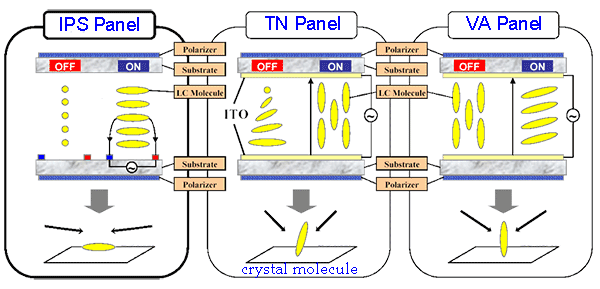
3.1. Twisted Nematic (TN) TFT LCD: Speed and Simplicity
TN panels are cost-effective and fast. Liquid crystals twist 90 degrees without voltage, blocking light when voltage is applied. They offer very fast response times and low production costs. However, they have poor color reproduction and limited viewing angles, exhibiting "gray scale inversion". Common in gaming monitors, budget laptops, and industrial control panel.
3.2. In-Plane Switching (IPS) TFT LCD: Color and Clarity
IPS technology addresses TN's limitations. Liquid crystal molecules align parallel to glass, then horizontally when charged, allowing consistent light modulation from wide angles. IPS panels excel in color accuracy and wide viewing angles (up to 178 degrees). They typically have higher production costs and historically slower response times than TN. Preferred for high-end monitors, professional displays, smartphones, tablets, and televisions.
3.3. Vertical Alignment (VA) TFT LCD: Contrast and Depth
VA panels align liquid crystals vertically without an electric field, tilting them when voltage is applied. This mechanism provides excellent contrast ratios and deeper blacks than TN and IPS. Viewing angles are wider than TN but generally not as wide as IPS. Drawbacks include slower response times than TN and potential subtle color shifting at extreme angles. Popular in televisions, computer monitors, and high-end displays where contrast is key.
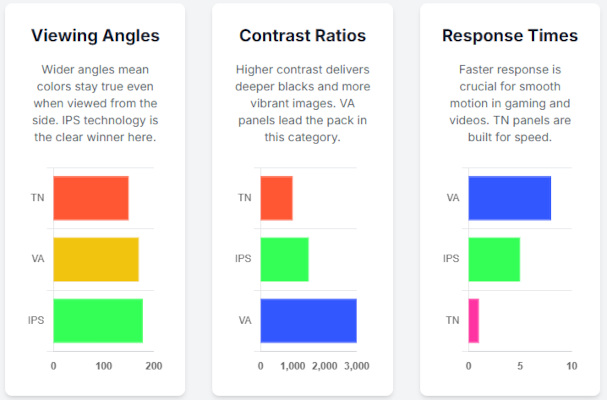
| TN | IPS | VA | |
|---|---|---|---|
| Liquid Crystal Arrangement | Twisted 90 degrees (no voltage), untwist (voltage) | Parallel to glass (initial), align horizontally (voltage) | Vertical (no voltage), tilt (voltage) |
| Typical Viewing Angles | Limited | Up to 178 degrees | Wider than TN, narrower than IPS |
| Contrast Ratios | Lower | Good | Excellent (deeper black) |
| Response Times | Fastest | Slower than TN | Slower than TN |
| Advantages | Fast response, low cost | Superior color accuracy, wide viewing angles | Excellent contrast, deeper blacks, wider viewing than TN |
| Disadvantages | Poor color, limited viewing angles, gray scale inversion | Higher cost, historically slower response, lower transmittance | Slower response, potential color shifting at extreme angles |
| Applications | Gaming monitors, budget laptops | High-end monitors, professional displays | Televisions, computer monitors, high-contrast displays |
4. Beyond the Panel: Transistor Technologies Shaping TFT LCDs
The performance and efficiency of a TFT LCD display are heavily influenced by the type of transistor technology employed.
4.1. Amorphous Silicon (a-Si) TFTs: The Industry Workhorse
Amorphous silicon (a-Si) TFTs are mature, stable, and cost-effective with high manufacturing yields. They are easy and inexpensive to manufacture, suitable for large displays, and exhibit superior high-voltage properties. However, they have lower electron mobility, leading to slower response times and resolution limitations. Used in standard computer monitors, televisions, and embedded systems.
4.2. Oxide TFTs (IGZO – Indium Gallium Zinc Oxide): Enabling High Resolution and Efficiency
IGZO TFTs are metal oxide semiconductors offering higher electron mobility and low power consumption. They enable higher resolution, improved transparency, and lower power consumption than a-Si. More expensive to manufacture than a-Si , they are used in 4K monitors, high-end tablets, and large-screen devices.
4.3. Low-Temperature Polycrystalline Silicon (LTPS) TFTs: For Premium Performance
LTPS TFTs are produced by transforming amorphous silicon into a polycrystalline structure, significantly increasing electron mobility. This results in very fast response times, high resolutions, superior power efficiency, and rich colors. Manufacturing is complex and expensive, with lower yields. Primarily found in high-end applications like premium smartphones, tablets, and laptops.
5.Connecting the Dots: Common TFT LCD Interfaces
TFT display Interface selection depends on application, display size, resolution, and host machine.
5.1. MCU (Micro Controller Unit)
Uses a parallel bus (8, 9, 16, or 18 bits). There are two types are popular in the market, 6800 and 8080. Simple, low power, no dedicated clock. Limited bandwidth, resolution, and color depth, with high pin count. Used in smaller screens, wearables, and compact industrial panels.
5.2. SPI (Serial Peripheral Interface)
Full-duplex synchronous serial communication. Low cost, low power, easy to implement. Limited bandwidth, resolution, and color depth. Suitable for simpler, low-resolution displays.
5.3. RGB (Red Green Blue)
TTL parallel bus (16, 18, or 24 bits). Offers higher bandwidth and color depth, straightforward implementation. High pin count, higher power, limited transmission distance, susceptible to noise. Used in industrial control panels, automotive dashboards, and some consumer electronics.
5.4. LVDS (Low-Voltage Differential Signaling)
Differential signaling for high-speed data over twisted-pair cables. Low noise, low power, reduced EMI, longer transmission distances. Requires differential pairs and precise impedance matching. LVDS interface is common in large LCDs and peripherals needing high bandwidth.
5.5. MIPI DSI (Mobile Industry Processor Interface Display Serial Interface)
MIPI DSI is differential signaling with clock pair and 1-8 data lanes. High speed, high bandwidth, low power, low EMI. Complex interface with high pin count, requiring sophisticated controllers. Standard for high-end mobile applications.
5.6. eDP (Embedded DisplayPort)
Digital interface based on DisplayPort, optimized for internal connections. High speed, high bandwidth, low power, low EMI. Higher cost and less widespread support. Embedded in tablets, notebooks, monitors, and large high-resolution displays.
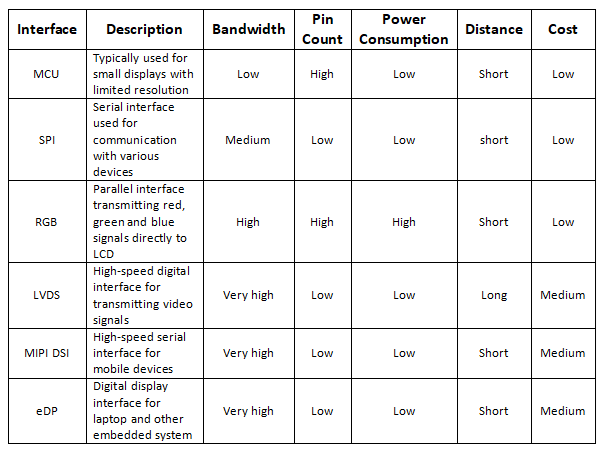
6. Advantages and Limitations of TFT LCD Technology
TFT LCDs offer a compelling balance of strengths and weaknesses.
Key Strengths
- Superior Display Quality: Sharp, detailed images with robust color reproduction. IPS variants ensure consistent color across wide viewing angles.
- High Resolution & Sharpness: Produce high-definition images with exceptional sharpness.
- Fast Response Times & Refreshing: Modern TFT LCDs achieve fast refresh rates (e.g., 144Hz), minimizing motion blur.
- Energy Efficiency: More energy-efficient than older CRT displays, extending battery life and lowering operational costs.
- Cost-Effective Production: Mature manufacturing processes keep costs low, enabling widespread availability.
- Durability & Longevity: Resistant to screen burn-in, making them reliable for long-term use, especially with static images.
Key Limitations
- Backlight Dependency: Requires a separate backlight, leading to poor contrast (blacks appear grayish), thicker screens, and higher power consumption compared to self-emissive OLEDs.
- Limited Flexibility: Rigid glass substrates make curved or foldable screens impractical.
- Color Depth Constraints: Cannot achieve the "infinite contrast" or vibrant HDR performance of OLED displays.
7.The Horizon: Future Trends and Emerging Display Technologies
The display industry sees continuous innovation, with TFT LCDs evolving alongside new paradigms.
Enhancements within TFT LCD: QLED and MiniLED
TFT LCD technology is enhanced by hybrid technologies like QLED and MiniLED to bridge performance gaps with self-emissive displays.
- QLED (Quantum Dot LED): Uses quantum dots to improve color accuracy, brightness, and energy efficiency in conventional LCDs.
- MiniLED: Employs thousands of tiny LEDs for precise local dimming, significantly improving contrast and HDR performance, nearing OLED quality.

Beyond LCD: Emerging Display Technologies
OLED (Organic Light-Emitting Diode): Self-emissive pixels allow for thinner, lighter, lower-power displays with infinite contrast and vivid colors. They can also be flexible. Disadvantages include susceptibility to screen burn-in, shorter blue OLED lifespan, and potential PWM dimming flicker.
MicroLED (μLED): Composed of microscopic, inorganic LED chips that are self-illuminating. Promises superior efficiency, higher brightness, greater durability, wider color gamut, and faster response times than LCD and OLED. Currently very expensive and faces significant manufacturing challenges. Considered the future of displays, expected to compete with OLED in certain markets within 3-5 years.
Conclusion: TFT LCD's Enduring Relevance and Future Outlook
TFT LCD technology remains a dominant force, balancing high image quality, responsive performance, energy efficiency, and cost-effectiveness. Its active-matrix design and advancements in panel and transistor types have ensured its adaptability across diverse applications. With ongoing innovations like QLED and MiniLED, TFT LCDs continue to enhance capabilities and compete with newer technologies. A growing commitment to sustainability will further shape its future, ensuring TFT LCDs remain a vital component of the global display landscape.
As a company with over 28 years experience in LCD field, Topway Display is always ready to help you picking the right TFT LCD for your next project.
